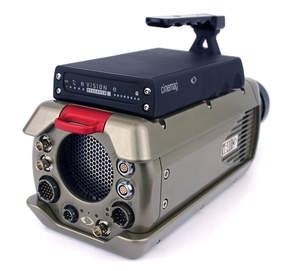Vision Research, a leading manufacturer of high-speed digital imaging systems, today unveiled the Phantom® v640, a four megapixel digital high-speed camera offering six gigapixel-per-second throughput and enhanced light sensitivity. To better serve its customers and meet their changing demands in an evolving marketplace, Vision Research is targeting an extensive new product launch schedule for 2009. The second major digital camera announcement of the year for Vision Research, the Phantom v640 is one of a record number of new high-speed digital imaging products, including new cameras, workflow solutions and customer convenience features, planned for 2009.

Targeted at industrial, military and R&D applications, which demand high-resolution imagery for maximum detail, the v640 offers a recording speed of greater than 1,400 frames-per-second (fps) at its full-resolution of 2,560 x 1,600. For higher frame rates, users can reduce the camera's resolution, giving them the ability to increase the speed of the Phantom v640 to meet the needs of their current shooting scenario. At a reduced resolution, the Phantom v640 offers a maximum frame rate of 300,000 fps.
Versatility abounds with the Phantom v640, as the camera can also record at more traditional frame rates for normal use, as low as 10 fps. When recording at 1,920 x 1,080, for example, users can achieve frame rates of 10 fps to over 2,700 fps. Such flexibility, especially when recording in high-definition resolution, positions the Phantom v640 as one of the most versatile, highest-performing four megapixel digital high-speed cameras on the market today.
State-of-the-Art CMOS Imaging Sensor
All Vision Research digital high-speed cameras incorporate a proprietary CMOS imaging sensor, custom-designed for the camera's intended applications. With a maximum resolution of 2,560 x 1,600, the wide aspect ratio of the Phantom v640's CMOS sensor allows a user to keep a moving target in the frame longer than when compared to traditional square imaging sensors.
The new four megapixel Phantom v640 also offers users breakthrough sensitivity. Vision Research engineers were able to make significant improvements from previous sensor designs, increasing the Phantom v640's peak quantum efficiency (QE) to 60 percent. The increased peak QE is also paired with a significant reduction in noise-equivalent power and Vision Research's micro-lens technology. Designed to increase the efficiency of the Phantom v640's CMOS sensor, micro-lens technology utilizes a tiny lens bound to each pixel to more effectively direct incoming light into the active areas of the photo site.
The Phantom v640 will be available with either a color or monochrome CMOS sensor, supporting both 8- and 12-bit pixel depths. Utilizing 8-bit pixel depth will yield longer record times and smaller file sizes, while 12-bit pixel depth will add additional gray levels for enhanced detail and clarity. The Phantom v640 color CMOS sensor is rated at ISO (ISO-12232 SAT) 1,000 and the monochrome CMOS sensor is rated at ISO 4,000.
The Phantom v640 also incorporates Vision Research's Extreme Dynamic Range (EDR) technology. EDR is a useful feature which allows users to capture two different exposures within one single frame. Furthermore, Vision Research adds to the overall ease of use and flexibility of the new Phantom v640 thanks to auto exposure, which automatically adjusts the camera to adapt to changing lighting conditions.
Effortless Calibration Ensures Accurate Images
New to Vision Research's Phantom v-Series is an internal mechanical shutter. During use, the response of a CMOS sensor's pixels can drift due to changes in resolution, exposure time and temperature, which can lead to inaccurate color representation and substandard image quality. To ensure optimal performance while using a digital high-speed camera, it's important to complete a session-specific black reference, otherwise known as a current session reference (CSR). A CSR will allow end-users to calibrate all of the CMOS sensor's pixels that will be used for a given set of camera parameters, setting all pixels to pure black -- an important step in ensuring the most accurate image possible.
Previously, to perform a CSR a user had no choice but to physically access the camera and cover the lens, a process which could be quite costly in regard to time, especially if the camera is mounted out of reach or used on a range for ballistics or explosion testing. Thanks to the Phantom v640's internal mechanical shutter, a CSR can now be completed remotely through a software command, even giving users the ability to automatically perform a CSR after every shot. The Phantom v640's internal mechanical shutter is also highly beneficial for applications requiring more than one camera, as a user can simultaneously perform a CSR for all cameras in use.
Vision Research's Phantom v640 is also the ideal high-speed imaging solution for particle image velocimetry (PIV) applications. The camera features a high-resolution timing system that yields a timing resolution of better than 20 nanoseconds, 1 mircosecond straddle time, as well as a frame synchronization signal available via a dedicated BNC for easier cabling and increased signal integrity.
Viewing Recordings
The Phantom v640 offers users several options to view recordings immediately, including a component video-out port for use with a viewfinder. Like the award-winning Phantom v12.1, the Phantom v640 also features Vision Research's Versatile Dual HD-SDI, which can be used in four different configurations. Users can take advantage of two identical 4:2:2 outputs, independent 4:2:2 outputs where one is live and one is playback, one dual HD-SDI 4:4:4 output, or 4:4:4 playback on the dual HD-SDI while the user has a live image on the component viewfinder.